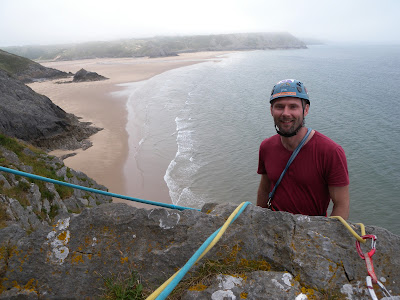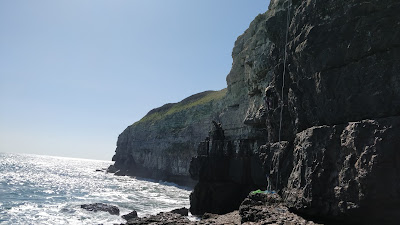The visiting climbers guide to rock climbing in the British Isles
The British Isles are not exactly world renowned for their abundance of rocky peaks. Many people might think of Britain & Ireland as a windswept Atlantic archipelago with an unsettled maritime climate and nothing more than a few low-lying hills and moorland outcrops. In fairness there is a degree of truth to that. However, with some effort and research, climbing in Britain can be as rewarding as anywhere on earth. Here are 7 tips for getting lots done.....
<NEXT POST PREVIOUS POST>1) Do your research on conditions and access
Its worth checking the access advice on the BMC RAD webpage. We do not always have the right to climb on any given cliff. Seasonal bird bans, army firing practice, and private ownership are just some of the restrictions that maybe encountered. Sea cliffs are particularly susceptible to bird restrictions. Check the BMC so you don't end up at Berry Head in the middle of the nesting season. Tides times are also important for many sea cliffs. Its essential to know the state of the tide and swell for safe access. Also best note the parking situation. Often its worth getting to the crag early if there is not much parking available.
Another factor is crag conditions. In a 30 degree summer heatwave heading to south facing Lawrencefield will get you fried! That said a 40-mph buffeting with a rough sea is also sub-optimal for sea cliff climbing. Check the weather not only for the days climbing but if heading to the hills start checking the forecast for the week previous. There's no use turning up at Cloggy if it's been hammering down for 5 days straight. North facing hill crags need time to dry. A general rule would be to hit the uplands and hills in hot summer weather and save the sea cliff for a bit later in the year when bans are lifted. That said our whether is quite fickle most the cliffs in the UK can be climbed throughout the year condition depending. High humidity is a factor that many visiting climbers might not consider. Coastal limestone can become almost unclimbable if the conditions give soapy "smeggy" rock. Friction on Gritstone is supposed to be great in dry cold weather - November onward often being optimal.
Here is a list of criteria to bear in mind when choosing a venue. Some are common to any climbing venue worldwide but there are some quite specific to the UK.
1) Wind speed and direction (particularly on sea cliffs).
2) Likelihood of rain showers (particularly on trad routes where retreat is problematic).
3) Tide times and tidal rage.
4) Sea state and swell height.
5) Approach length (often surprisingly long even for some small outcrops were walking in laiden with too much can make the climbing feel not worth the effort)
5) Humidity (important to know for limestone sea cliffs)
6) Midge likelihood (especially in Scotland)
7) Bird Bans (not just on sea cliffs but inland too - also note shortly after bans are lifted sea cliffs can be guano covered. It won't stop climbing but can make it umpleasant).
8) Other bans and red tape (military firing bans, tourist bans, seal pups, conservation areas etc).
9) Recent rainfall (ie. likelihood of crags being wet or out of condition)
10) Recent ascents (likelihood of crags being overgrown or dirty)
11) Sunshine levels (can actually be an issue in mid summer)
12) Parking availability or potential for overcrowding (worth noting)
13) Grade range of routes available (especially if its going to be busy)
2) Be prepared to drive
Despite some excellent development on the south coast, most the best rock (and unique climbing experiences) is found in the North, The North West, or the West. Particularly the extremities of the archipelago. If you want a good overview of climbing here, get in the car and get to these remote places. Some of the best rock is found on the smaller islands -Anglesey, Lundy, Pabay, Skye (even Portland is an island).
 | |
|
3) Be open minded and diversify (embrace the esoterica!)
Britain has had to utilize almost every scrap of climbable rock. This has led to the most unlikely rock types being developed for climbing. There really is some great variety here. Okay some of it might be a bit "esoteric" but rest assured, in the right conditions there is some real quality. Quarry climbing is now an important part of British climbing. Don't be put off by climbing in a man-made hole. Great sport climbing can be had in these places, and they are often quite pleasant. Also, its worth climbing quirky routes - sea stacks, enchainments, wet chimneys, slate desperates, traverses (remember we are sometimes forced to climb sideways here), or climbing into sea caves (and finding a way out!). Just some of the great adventures to be had in Britain.
 |
| Esoteric traversing at Wintours Leap |
 |
| A man-made eyesore?- Or sport climbing paradise? |
 |
| Great quarried sport climbing |
I should point out that being competent at trad climbing is an essential asset. Traditional climbing ethics are integral to climbing here and being able to place gear and build belays is a requirement for the majority of climbing venues.
4) Own a good rack of gear and ropes
If money was no barrier, then I would suggest the following gear....
A double set of nuts (with a good set of micros and brassies), A full set of cams (micro to say, no4 BD Camelot), many quick draws (preferably with 20cm slings) . Extendable "Alpine " quick draws (about 5).
Optional gear - Tricams, Hexes (for some limestone venues) .
A clip stick and/or a "panic" quick draw (both good for more esoteric sport venues)
A sport rope of course. 60m is sufficient.
A static abseil rope (50m or even 60m, though some venues require much longer).
A set of half-ropes. Generally, 50s will do, though again, a few venues will require 60s. Many crags however are so short doubling over one rope is sufficient.
Helmets, belays devices, slings etc (all standard stuff).
 |
| A essential long Abseil rope |
5) Learn the British Trad grading system
This old system is baffling to most foreigners however rest assured it works well for describing short trad climbs. There's an overall difficulty rating (adjectival, and denoted with an acronym). This is coupled with a technical rating (a number) which denotes the hardest move or sequence on the route. This two-tier system combined with guidebook description (and a good deal of actually looking at the route) gives a good indication of what you're getting yourself into.
The system is as follows (with the commonly used acronym).
Diffs. Considered easy low-grade routes. Great for cold days in the hills, climbing in big boots or soloing. These low grade routes do not have a technical grade.
Moderate - MOD (Essentially scrambling on very easy terrain)
Difficult -DIFF
Very Difficult -VDIFF
Hard Very Difficult - HVD
Severes. Starting out relatively easy by modern standards, however HVS is very much a mid-grade climb and probably the average grade that most fit, frequent weekend climbers operate at...
Severe - S 4a
Hard Severe - HS 4b
Very Severe - VS 4c
Hard Very Severe - HVS 5a
Extremes..
You're starting to cook with gas here. Anything that starts with an E is to be treated with caution. That's to say things get harder and more serious. This for some is where the fun begins...
Extremely Severe 1 - E1 5b
Extremely Severe 2 - E2 5b/5c
Extremely Severe 3 - E3... 5c/6a
Extremely Severe 4 - E4 etc....
6) Get as fit as you can (but also drop your grade)
This goes without saying that the better you climb then the more route options are available. This is true of any climbing location. If you can on-sight E3 on most rock types (and get up French 7b+ on bolted climbs) you'll really be able to sample some of the country's best routes. While there is plenty for the lower grade climber too, climbing in the Extremes will open up many crags. I lose count of the amount of great looking crags I've seen in guidebooks that require that teams climb in the Extremes to warrant a trip there. Also it can be prudent to have a grade or two in hand at some venues.
However British climbing isn't about chasing grades. The are many moderate and lower grade classics that require a competent party with good rope management, efficiency, and experience. Don't shun easy VDIFFs that weave their way up ridges in the hills.
Sport climbing in Britain is limited when compared to mainland Europe. However, climbing in the 7s will get you on the best routes that compare with the best in the world.
7) Climb mid-week
Good crags with good access are becoming increasingly busy at weekends. Parking is becoming difficult and on occasion even finding a free route is hard. On occasion this can detract from the whole experience. There are still plenty of quiet corners of course and being alone at the crag is still not uncommon. However, if other commitments allow, climb midweek during the summer - you'll have the crags to yourself.
Britain has a wealth of great routes - from adventurous outings requiring commitment and competence to pristine sport climbs in beautiful settings. But there is also something a bit different, something unusual. Strange mediums to climb on (slate, grit, quartz sandstone, even chalk) . An abundance of traditional routes without the use of bolts not even for the belay! Weird and wonderful sea stacks and traverses that meander into remote sea caves and out of blow holes. These are things that make British climbing so special.
 |
| Caving or climbing? |

















